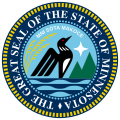| |||||||||||||||||
| |||||||||||||||||
 County results Sant: 40–50% 50–60% 60–70% 70–80% 80–90% Rosing: 40–50% 50–60% 60–70% | |||||||||||||||||
| |||||||||||||||||
The 1902 Minnesota gubernatorial election took place on November 4, 1902. Republican Party of Minnesota candidate Samuel Rinnah Van Sant defeated Democratic Party of Minnesota challenger Leonard A. Rosing.


